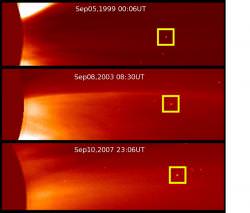The most successful comet hunter is not some dedicated amateur who sacrifices night after night searching for icy bodies from the outer Solar System. It’s not a robotic telescope surveying the heavens. Nope, it’s SOHO – a space telescope staring at the Sun; and it discovers comets as a happy side benefit. But recently it turned up something new, one of Halley’s cousins; a periodic comet.
The object is called P/2007 R5, and it wasn’t the first time SOHO had captured images of it. The satellite had actually seen this rare variety of comet on two separate occasions in the past. Instead of falling into the Sun and being destroyed, or getting flung out into a wild orbit, P/2007 R5 takes a very regular elliptical orbit around the Sun.
So if P/2007 R5 had been seen three times by SOHO, why hadn’t anyone noticed before? SOHO sees a lot of comets on a lot of orbits. German PhD student Sebastian Hoenig did notice. He realized that an object that passed by in 1999 had a very similar orbit to another object that came by in 2003. Hoenig calculated the orbit, and predicted that it would be back on September 11, 2007. His prediction was surprisingly accurate; the comet passed through the field of view again, right on schedule.
With that mystery solved, there’s still something puzzling astronomers. P/2007 R5 doesn’t look like a regular comet. It doesn’t have a tail or coma, and some astronomers initially wondered if they were looking at an asteroid, and not a comet. However, on its most recent pass, astronomers were able to study P/2007 R5 a little better, and saw that it does exhibit some cometary behaviour. When it passed within 7.9 million km of the Sun, it flared slightly, just like a comet should.
It’s possible that P/2007 R5 is actually an extinct comet; an object that lost all its volatile gas and ices to the Sun long ago. Objects like this have been long theorized, but never observed.
Original Source: ESA News Release

